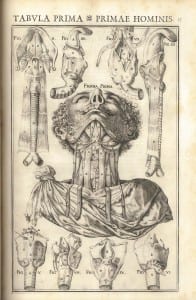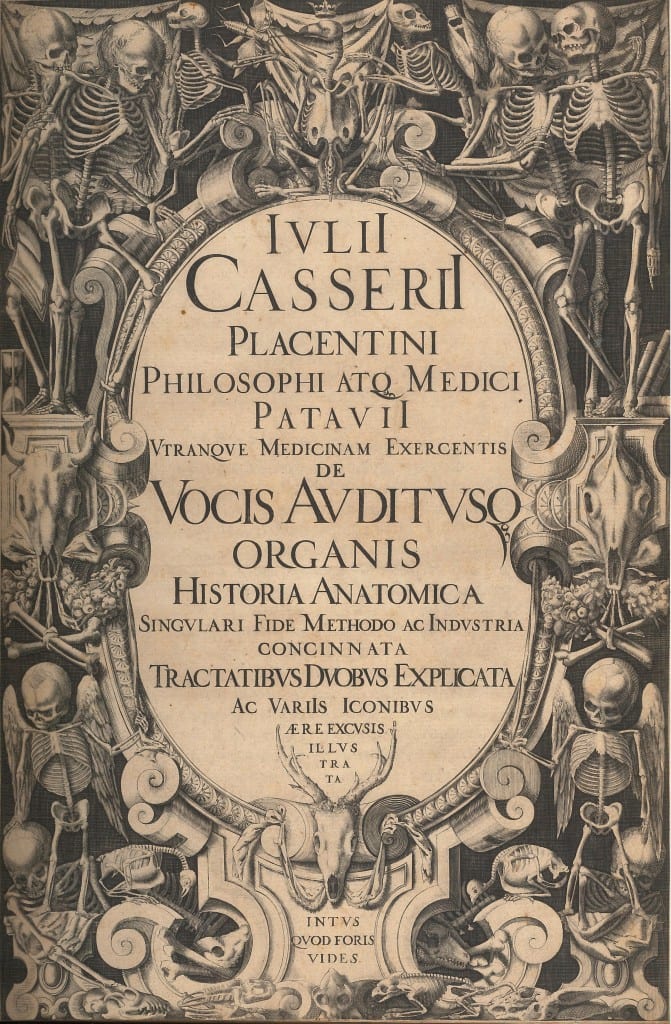Julius Casserius Placentinus 1552 -1616
By H Dominic W Stiles, on 23 May 2016
 It is always hard to choose a favourite book – but this book by Giulio Cesare Casseri or Julius Casserius Placentinus (ca. 1552-1616) has to be one of my favourites in our collection. Placentinus means he was from Placentia – Piacenza (latin ‘pl’ becomes ‘pi’ in Italian).
It is always hard to choose a favourite book – but this book by Giulio Cesare Casseri or Julius Casserius Placentinus (ca. 1552-1616) has to be one of my favourites in our collection. Placentinus means he was from Placentia – Piacenza (latin ‘pl’ becomes ‘pi’ in Italian).
The book’s title is, De vocis auditusque organis historia anatomica : singulari fide methodo ac industria concinnata tractatibus duobus explicata ac variis inconibus aere excusis illustrata. It was published in 1600 in Ferrara. It had an important contribution to otorhinolaryngology for no one had produced such as detailed anatomy for the laryngeal structures and of course they were working without the benefit of microscopes though they possibly used lenses for magnification (Martin). The illustrator is supposed to be the Swiss artist, Joseph Mauer (or Josias Murer to use the latin form of his surname), who lived with Casseri while he was working on the anatomy. The title page, crested with a skeletal eagle, is reportedly by Jacopo Ligozzi.
 Giulio Casseri was born to a very poor family. The date of his birth is uncertain, and the date 1552 is based on his will while the date sometimes seen of 1561 is based on a portait that does not appear in our copy*. Casseri had gone to Padua perhaps initially as a servant to a student, then working as his servant to the great anatomist at Padua, Fabricus ab Aquapendente, under whom he learnt anatomy. We do not know when he graduated as a student but ca 1580 is the guess of the best authorities (Riva et al). He was soon held in high regard, becoming an examiner in place of Fabricius in 1584. They fell out over this perhaps and over teaching methods. Fabricius taught in public while Casserius ran a private course from his home. The students seem to have preferred the intimacy (Riva et al.p.169). In her book, Theaters of Anatomy, Cynthia Klestinec says,
Giulio Casseri was born to a very poor family. The date of his birth is uncertain, and the date 1552 is based on his will while the date sometimes seen of 1561 is based on a portait that does not appear in our copy*. Casseri had gone to Padua perhaps initially as a servant to a student, then working as his servant to the great anatomist at Padua, Fabricus ab Aquapendente, under whom he learnt anatomy. We do not know when he graduated as a student but ca 1580 is the guess of the best authorities (Riva et al). He was soon held in high regard, becoming an examiner in place of Fabricius in 1584. They fell out over this perhaps and over teaching methods. Fabricius taught in public while Casserius ran a private course from his home. The students seem to have preferred the intimacy (Riva et al.p.169). In her book, Theaters of Anatomy, Cynthia Klestinec says,
Fabrici’s teaching was frequently described as disordered and incomplete, while the lessons of Paolo Galeotto and Giulio Casseri (Iulius Casserius, 1561-19) were described as comprehensive and clear. Galeotto and Casseri also offered “beautiful” dissections, a description that points to a technical skill that was rarely noted in Fabrici’s courses. Galeotto and Casseri were able to maintain an emphasis on the details of anatomical structures, gradually extending their comprehensive demonstrations into areas of natural philosophy. Such particularities, analyzed in detail and over time, provide the foundation for the spectacular appeal of anatomy both inside the walls of the university and beyond. (Klestinec, 2011, p.11)
[…] When Casseri substituted for Fabrici in the public anatomy in 1604, one student noted that Casseri’s demonstration was “useful in the most important ways to the students”; “he read to the students and demonstrated ocularly this anatomy … everybody was able to see particularly all the parts … [and] the ways of treatments.” (ibid p.164)
 It is a pity their feud persisted, and that Casserius did not live to see the other plates he had prepared on anatomy published. They eventually came out in 1627 where his work was combined with that of Spigelius. Hast and Holtsmark say, in their introduction to the partial translation,
It is a pity their feud persisted, and that Casserius did not live to see the other plates he had prepared on anatomy published. They eventually came out in 1627 where his work was combined with that of Spigelius. Hast and Holtsmark say, in their introduction to the partial translation,
the detailed description Casserius gives of the laryngeal muscles has no equal in the contemporary antomy of his day. […] It is true that his work does suffer from the inherited scholasticism of the Middle Ages; William Harvey’s famous publication was twenty-seven years in the future and “scientific” thinking was still teleological. But Casserius, unlike many future students of anatomy, could approach his work without the preconceived notions we all obtain from studying the standard textbooks of anatomy (with their beautiful illustrations), guiding our knife on its proper course. He learnt his discipline by that invaluable but laborious method of making dissections by himself. Therefore, if the reader does not always find Casserius’ description of the course of a muscle as he would expect or was taught, let him return to the dissecting room with an unprejudiced mind and without notes or textbooks.
Our copy came from the bookseller Tregaskis. It is virtually in mint condition so probably never sat long on the desk of a student or anatomist, where I might have expected it to be better used, however, there is no frontispiece portrait in our copy so perhaps it was rebound.
The illustrations are fabulous! There are dissections of animals and people, including a pike, (Esox lucius) and a goose (Anas anser). I have not space for more images but you will find many on line.
 Here we see the illustration of a ‘laryngotomy’ – a tracheotomy.
Here we see the illustration of a ‘laryngotomy’ – a tracheotomy.
Note:
*To my mind the latter date does not seem to give him sufficient time to become experienced enough to be an examiner in 1584.
As usual, click on images for a larger size.
Casserius J. De vocis auditusque organis historia anatomica. Ferrara: Victorius Baldinus, 1601. Partial modem translation: Casserius J. The Larynx, organ of voice, translated from Latin by Malcom H. Hast and Erting B. Holtsmark. Acta Otolaryngol 1969; suppl 261
Housman, Brian ; Bellary, Sharath ; Hansra, Simrat ; Mortazavi, Martin ; Tubbs, R. Shane ; Loukas, Marios. Giulio cesare casseri (c. 1552–1616): The servant who became an anatomist. Clinical Anatomy, 2014, Vol.27(5), pp.675-680
Hunt, D. Julius Casserius. The Boston Medical and Surgical Journal, 1878 p.269-71
Klestinec, Cynthia, Theaters of Anatomy: Students, Teachers, and Traditions of Dissection in Renaissance Venice. Baltimore: Johns Hopkins University Press, 2011
John Martin, M.D., The Vesalian School of Anatomy in Renaissance Padua
 Close
Close


